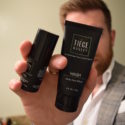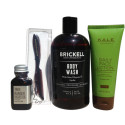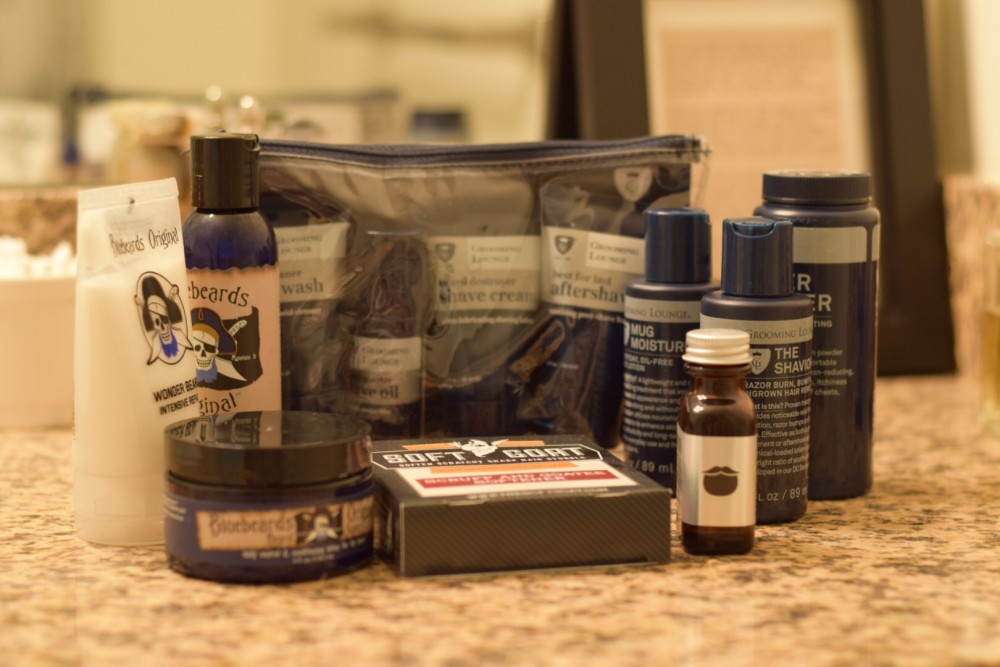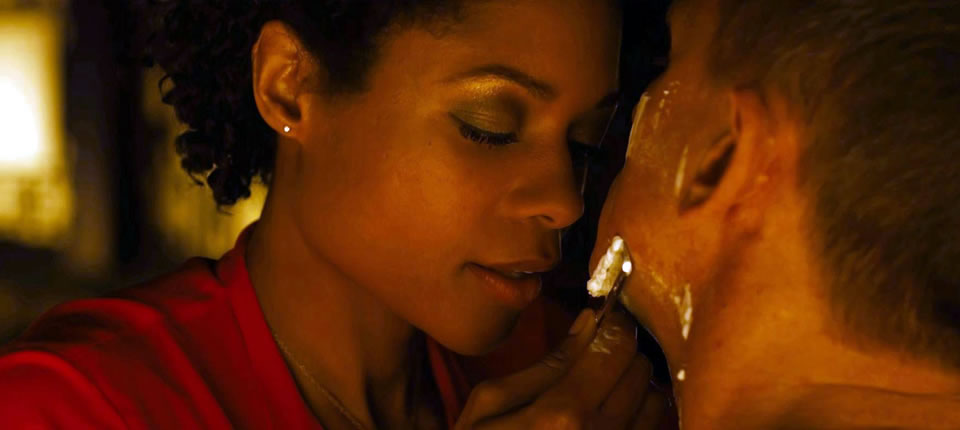So you read yesterday’s post and decided a beard isn’t for you. Great. Here’s how to get the best result when shaving.
There are two distinct methods to shaving: Dry Shaving & Wet Shaving, with each of these having sub-methods that I’ll detail below.
Dry Shaving:
1. Electric Razors were first patented in 1928 and were designed for dry skin only. Many recent electric razors have been designed to allow for wet/dry use, which also allows them to be cleaned using running water or an included cleaning machine, reducing cleaning effort. Some patience is necessary when starting to use a razor of this type, as the skin usually takes some time to adjust to the way that the electric razor lifts and cuts the hairs. They also require the hair to be extremely short already as anything longer than 5 o’clock shadow can cause the blades to jam or tug on the hair causing an uncomfortable shave.
2. Depilatories are razorless creams/powders/gels that use chemicals to break the disulfide bonds in the keratin and allow it to be scraped off the skin at the surface. As the epidermis is also rich in keratin, the skin may become irritated and sensitive if the preparation is left on for too long. Regular use of chemical depilatories may result in hair root neutralization for a longer period of time than usual. They’re akin to a mild chemical peel so they are not for those with sensitive skin but can be used effectively with extremely curly facial hair.
Wet Shaving

1. Conventional Straight Razors were first patented by an English manufacturing company in 1680 and haven’t changed much since their inception. The most difficult of shaves, yet the most satisfying (if I do say so myself), the straight razor requires a high initial investment in not only the razor, but a strop and hone and other materials making it out of the realm of impulse purchases. The grind & depth of the hollow, point profile, blade length, blade width, scale, and pivot mechanism are all important factors in choosing a razor; as are the choices of strop materials, hone types, grits and cleaning methods. A good razor can go upwards of $200, strops from $90 to $300, and hones from $50 to $150. This doesn’t include the steep learning curve associated with straight razors, as they can be extremely dangerous in inexperienced hands.
Disposable straight razors are a unique modern invention as they utilize the principles of straight razor shaving but eliminate the aftercare as once the blade becomes dull, a new one can be quickly changed out.
2. Safety razors came to popularity after King C. Gillette introduced the disposable razor blade in 1901 and gave men a way to shave at home that didn’t threaten them with death and dismemberment the way straight razors have been known to do. The predecessor to the cartridge razor of today, the safety razor’s design simplifies the 30° angle necessary to shave hair correctly and because of the single blade design, they don’t have to deal with clogging issues as much as modern razors.
Disposable safety razors are a thing too! BiC invented them in 1974
3. Cartridge Razors followed quickly behind safety razors as manufacturers moved away from steel and into plastics. Gillette introduced the twin blade Trac II razor in 1975, the triple blade Mach 3 in 1998, the four blade Quattro, five blade Fusion and six blade Dorco in the two decades after. All of them function on the same basic principle of “Hysteresis” which is that the first blade in the model serves to “lift” (pull) the hair out further from the follicle opening in the skin and the blades there after shave the hair so close that it actually retracts underneath the surface of the skin providing a very smooth shave. This however can lead to skin irritation as each pass of the razor is multiplied by the number of blades i.e. one pass of a fusion blade is like 5 passes with a single safety razor. Also the issue of cutting the hair so it retracts below the skin’s surface can lead to a condition called pseudofolliculitis barbae or colloquially known as razor bumps wherein the skin grows over the follicle opening causing ingrown hairs.
The “razor and blades” business model, the sale of dependent goods for different prices – one good is sold at a discount, while the second dependent good is sold at a considerably higher price – actually comes from King C. Gillette’s initial marketing campaign of the safety razor. Videogame companies use this same business model today.
You’ve undoubtedly skipped ahead looking for the part where I talk about getting a better shave, so I’ll save your scrolling thumbs and explain how to get your best shave.
SHAVING – THE STRAIGHT AND NARROW PATH
Preparation or Pre-shave.
As my mentor told me, so shall I reveal to you: “A face well prepared is half-shaven to start”. This is the step that most guys will skimp on because it is the least given attention to by shaving companies. Blade innovations are paramount to them, but no amount of blades or their sharpness will ever cover for an improperly prepared face.
1. Wash your face to start with and if you’re shaving more than 3 weeks growth I suggest using clippers/trimmers to bring it down to a manageable level. You can also shave in the shower if one has a fogless mirror or right after. If not, make yourself a few hot towels and apply them to your face making sure to remove them as soon as they start to get warm. Others will say to leave it on for at least 2 minutes or more, but that doesn’t matter if your towel isn’t hot. The heat is important for several reasons:
a. The heat relaxes the skin, and muscles making your face more pliable allowing it to stretch easier to both manipulate the blade over, and to allow the blade a certain leniency with “skipping” which is where the blade applied to the face with too much pressure, and the skin behind it not being held in place, literally “jumps” over small sections of skin possibly cutting when it lands. Pliable skin can skip without too much fear of injury so if you’re bad at shaving, your hand isn’t quite so steady or your grip fails you, it won’t always spell disaster for your face.
b. When applied to hair, water breaks the hydrogen bonds present in the keratin cells and softens it. Pretty much it is like the Imperio Curse for your hair; it becomes completely malleable while it is wet. Hot water doubly so. Broken hydrogen bonds turn stiff-as-copper-wire hair into something a razor can easily slice through, reducing tugging and pulling that would otherwise plague a razor on dry skin.
2. Apply shaving oil. This has less to do with the interaction between the razor and the hair as it is for the razor and the skin. Applying an oil first helps to re-establish a moisture barrier on the skin’s surface so that as you begin to shave the razor has a micron-thin lipid layer that it will remove before it will begin to remove micron-thin layers of epidermal cells.
3. Lather it up. Lather’s functions are actually a little more complex than one might think. At first glance it’s to create a smooth surface for the razor to pass over, but traditional lather has its roots in soaps. Lather, due to its pH, actually attracts the dirt and gunk (dead skin cells, club hairs, sweat, food particles, air pollution entities etc..) buildup on your face and bonds with it so that as one shaves the lather cleans the face. Lather also serves to maintain a microclimate of heat and water against your skin, so that while one side of the face is being shaved, the other half isn’t drying out and the hairs aren’t reforming hydrogen bonds. Shaving is a race against the clock and lather dramatically extends that time. You can use your hand to lather up but the best lathering method is with a brush. The greatest benefit from shave brush use to lift facial hair and surround the follicle with hot water and lather. Applying shaving cream by hand mats hair or raises it unevenly and can’t get close enough to the skin to have the same effect. The microclimate created by hand lathering can lead to pockets of un-lathered dry skin.

The modern badger brush can be traced back to France during the 1750’s where it was known as a blaireau. Brushes come in 3 different qualities, with a handful of delineations beyond that.
- Horsehair makes up the cheapest of the cheap shaving brushes. It is very coarse and does not retain water very well making lathering difficult with shaving soaps.
- Boar hair is relatively inexpensive but can be made high quality. Though coarse, repeated use causes the hair in higher-end brushes to split resulting in a brush that is very soft but has considerable backbone. The boar’s hair is also water absorbent and needs to be soaked in water before use to be fully effective. This has its drawbacks though if the brush is not left to dry completely it can become mildew infested and ruin the brush permanently.
- Badger hair is touted as the supreme brush component, and is rightly so for a number of reasons. The lowest quality badger brush is still leaps above even the best-made boar brush. Badger hair specifically because of its water retention qualities. Badger hair has no official standard grading scale for quality but industry wide there are basic classifications for badger hair that are as follows:
- “Pure” Badger hair (or just Badger) comes from the underbelly of the badger, around 60% of its fur. The coarsest of the badger due to its thickness, the ends of the brush are often trimmed to a shape resulting in stiff, rough ends
- “Best” Badger hair is made with finer and more pliable hairs and allows for a better lather, though the quality between a pure and best is often negligible and the handle and bristle knot size being the biggest difference of the two.
- “Super” badger hair is the finest 20%-25% of Best hair and usually due to its coloration will often resemble the higher-grade silvertip.
- “Silver Tip” hair is pulled from the neck area of the badger and is the most expensive and rare type of brush hair. Its vastly superior water retention qualities and un-paralleled softness make this the ultimate shaving brush. Like driving a Rolls Royce over your face.
- “Extra Silver Tip” brushes only exist in the highest echelons of the shaving world and are almost exclusively custom made by hand and run easily $1,000+.
Time to shave
You’re all lathered up, blade in hand, now what? Well by this point, you’ve already examined the growth patterns on your face right? No? Well you should have. Knowing your growth patterns is key because the first time around with the razor you’re going to shave with the grain. If you’re trying a new style of razor it is important to only go one direction at first so you can both get a feel for your new tool and so you can see how your face responds to it as well. If you’re fighting your face with removing hair going with the grain, you can save yourself a lot of hassle and skip against the grain because it will only be a painful disappointment.
Use your free hand and with three fingers, gently hold your skin in place as you shave away from your hand with the growth. Take care not to pull your skin too far out of place as this is the same “Hysteresis” technique whereby the hair is uprooted from the follicle further than normal causing it to be shaved so close it will retreat under the skin when you remove your hand from your face. Let the weight of the blade do the work as pushing the blade into your skin will always be something you regret. As for stroke length, I will tell you what my mentor told me: “As long as you dare. The first stroke shaves the hair, each stroke after that just irritates the skin”. It’s not about long or short, it is the fewer the better. The elasticity of your skin will tell you how long you can comfortably make each stroke, and for myself each stroke is about as long as my index finger. Beyond that the blade is too far away from my opposing hand and the skin will bunch, skip, and I will often end up with a nick. Each face is different so there is no right way to shave it. When I teach straight razor self-shaving classes at my shop I have to cater my lesson to the clients unique facial structure. Once you’ve shaved your whole face with the grain you can decide to re-lather (and I suggest using a hot towel as well) and go cross-grain as a second pass and even lather up a third time and go against the grain. Again, go for least number of strokes with minimal pressure to reduce the chance for irritation.
Post Shave or The Home Stretch
Come on! You’ve stuck with me this far, just a little bit longer. So you’ve shaven with, cross or against the grain (or all three for truly svelte skin) and now its time to finish things off. If you have any nicks or cuts, an alum block rubbed allover the face, or nick powder applied with a Q-tip will help close things off. Anything larger than a paper cut and you might need to apply pressure and treat it like you would any wound, even making the trip to the hospital if you really get yourself good. Assuming you got off scot-free the first step is to very gently wipe any remaining lather. Don’t rub anything against your face as your razor has revealed a fresh new layer of skin cells and it’s in a very fragile state right now. Rinse your skin with cold water, as this will begin the process of closing your pores and tightening your skin. Apply an alcohol free aftershave, or toner, as its job of rebalancing your skins’ pH in preparation for a moisturizer is vital. Apply your aftershave balm or moisturizer (either or, they’re most likely the same thing – make sure it is oil free) last. I like to go one extra step and apply a cold towel to my face after the moisturizer as a way to really help lock it in. Optionally you can apply a light coating of talc or barber’s powder to eliminate any remaining moisture on your face so you don’t look like you just got a shave. Clean your razor, replace your blade if necessary, rinse your brush well and let it hang to dry (or place it sideways on a towel if you don’t have a brush stand) and you’re all done.
That about covers hair care on your face, I left some things out purposefully as they weren’t fitting here but they’ll be in the companion piece to this one. As always, I’m just a barber, not a doctor so if you have serious issues go see someone with a degree and get their opinion. Try new things, experiment, read reviews, get samples and honestly do it for you. Shaving should be a ritual that you enjoy. Not a miserable experience you have to do because of some employee handbook rule or girlfriend stipulation. Take pride in your equipment, your skill and make it your own. Be intentional about your shave and it will be an enjoyable experience akin to one at the barbershop. During a scene in Skyfall, British actress and femme fatale Naomie Harris gives 007, played by Daniel Craig, a close shave using a cutthroat razor, whispering in his ear “sometimes the old ways are the best” as she performs the shave. Online retailers around the world saw increases in sales of razors up 50% to as much as 400% just because of that scene. Shaving is a unique phenomenon to men as barbers were held in such high regard in the past and certain esteem has been appointed to shaving with a brush and razor over the due course of time that it is an awe inspiring skill to have in ones repertoire. I hope you’ve learned a little bit and the next time you shave you are able to look at it through new eyes and can have a personal and enlightening experience in the few moments you have to yourself before you have to plug back into the Matrix.













